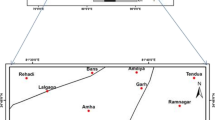Abstract
The present study was carried out to delineate and characterize ground water prospect zones using IRS-ID LISS-III geocoded data on 1:50,000 scale. The information on lithology, structure, geomorphology and hydrology were generated and integrated to prepare ground water prospect map for a region in western Rajasthan. The information on nature and type of aquifer, type of wells, depth range, yield range, success rate and sustainability were supplemented to form a good database for identification of favourable zone. Geographical Information system (GIS) was used to prepare database on the above layers, analysis of relationship and integrated map preparation. The study area has a complex geomorphology. The geology is dominated by rocks of post Delhi Intrusive and Quaternary sediments. On the basis of hydrogeology and geomorphic characteristics, four categories of ground water prospect zones: high, moderate, low and very low ere delineated. The high prospect zones are alluvial plains and valley fills mainly influenced by quaternary formations with yield expectation between 100-200 lpm. The moderate zone has pediment surfaces covered by shallow soil cover in addition to weathered and fractured aquifer material with expected yield of water between 50-100 lpm. The low potential zones mainly comprise inselbergs and rocky surface with expected discharge below 50 lpm. The very low prospect zones act as run-off generating zones.
Similar content being viewed by others
References
Adyalkar, P.G. (1964). Palaeogeography, sedimentological framework and groundwater potentiality of the arid zone of western India. Proc. Symp. Problems of Indian Arid Zone, held at Jodhpur from Nov. 23-Dec. 2, 1964, pp. 4–16.
CAZRI (1996). Integrated natural and human resources appraisal for sustainable development of Sikar district. CAZRI, Jodhpur.
Chatterji, P.C., Singh, S. and Qureshi, Z.H. (1978). Hydrogeomorphology of the central Luni basin, western Rajasthan (India), Geoforum,9(3): 211–224.
Ghose, B. (1965). The genesis of the desert plains in central Luni basin of western Rajasthan. J. Indian Soc. Soil Sci.,13(2): 123–126.
Ghose, B. and Singh, S. (1975). Geomorphology of prior and present drainage networks and their control on ground water in sandstone formations, Jodhpur district, Annual Report, CAZRI, Jodhpur.
Gopalan, A.K.S. (2001). High-resolution imageries for developmental planning, www. gisdevelopment.net/2001, pp. 1–7.
Heron, A.M. (1935). Synopsis of the pre-Vindhyan geology of Rajputana. Tr. Nat. Inst. Sci. India1(2): 17–33.
NRSA (1995). Integrated Mission for Sustainable Development (IMSD)—Technical guidelines, National Remote Sensing Agency, Hyderabad.
NRSA (2000). Technical guidelines for preparation of ground water prospects map, Rajiv Gandhi National Drinking Water Mission, National Remote Sensing Agency, Hyderabad.
SAC (1986). Report on the ground water potential maps of Rajasthan (Based on visual interpretation of Landsat Thematic Mapper Data), Space Application Centre, Ahmedabad.
Sahai, B. (1993). Remote sensing of deserts, the Indian experience, J. Arid Environments, 25(1): 173–185.
Sahai, B., Rajawat, A.S., Bahuguna, I.M., Arya, A.S., Sharma, A.K., Sharma, D.C., Porwal, C.P., Chakraberty, S.K. and Rathore, D.S. (1993). Hydro-geomorphological mapping of Jaisalmer and Bikaner Districts (Rajasthan) at 1:50,000 scale using satellite data, J. Arid Environments,25(1): 163–172.
Shankarnarayan, K.A., Chatterji, P.C. and Singh, S. (1983). Role of remote sensing in ground water extraction for problem villages and habitants of hard rock regions of western Rajasthan.Proc. 2nd All India Conf. Drilling Equipment for Groundwater Extraction held at New Delhi, pp. 1/3–1/25.
Srivastava, A., Tripathi, N.K. and Gokhale, G.K. (1999). Basement topography and aquifer geometry around Ken Garden, India, Int. J. Remote Sensing,20(11): 2295–2305.
Author information
Authors and Affiliations
About this article
Cite this article
Khan, M.A., Moharana, P.C. Use of Remote Sensing and Geographical Information System in the delineation and characterization of ground water prospect zones. J Indian Soc Remote Sens 30, 131–141 (2002). https://doi.org/10.1007/BF02990645
Received:
Accepted:
Issue Date:
DOI: https://doi.org/10.1007/BF02990645




